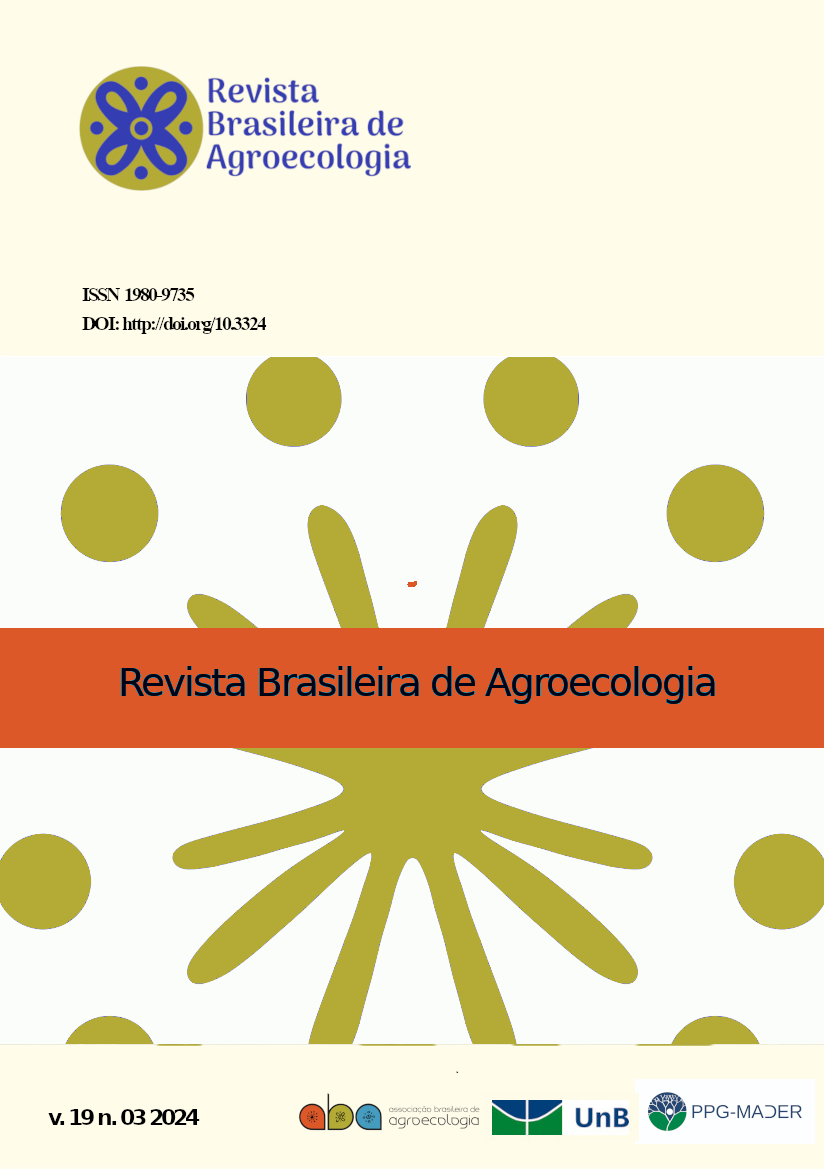INCREASING TOLERANCE TO RUST AND DROUGHT OF FIG PLANTS TREATED WITH DYNAMIZED HIGH DILUTIONS
DOI:
https://doi.org/10.33240/rba.v19i3.51512Keywords:
Ficus carica, Cerotelium fici, Homeopathic preparationsAbstract
This work aimed to evaluate the impact of dynamized high dilutions on rust development and yield fig plants. Studies were conducted in the field. The experimental design was in split-plot, with five replications. The treatments were Belladonna, Thuya occidentalis, and nosode of fig-rusted leaves, all at 30 CH – centesimal Hahnemannian dilution order. Distilled water was used as the control. The cultivars used were Roxo de Valinhos and Branco Rosa Lages. Spray applications were performed every 15 days. The incidence and severity of rust Cerotelium fici were evaluated every seven days. The number of fruits per plant was counted. Belladonna reduced the severity of rust. Thuya occidentalis and nosode improved leave persistence. Dynamized high dilutions are a potential strategy to improve the tolerance of fig plants to drought and rust.
Downloads
References
BOFF, Pedro.; VERDI, Rovier.; FAEDO, Leonardo. F. Homeopathy applied to agriculture. Em: WRIGHT, Julia.; PARROTT, Nicholas. (Eds.). Subtle Agroecologies. 1. ed. Boca Raton: CRC Press, 2021. p. 145–154.
BOLIANI, Aparecida. C. et al. Advances in propagation of Ficus carica L. Revista Brasileira de Fruticultura, v. 41, n. 3, p. e-026, 2019.
FAOSTAT. Fig world production. Available in: https://www.fao.org/faostat/en/#data/QCL/visualize. Accessed in: 15 mar. 2023.
GALLETI, Silvia. R.; REZENDE, Jorge. A. M. Doenças da Figueira. Em: AMORIN, L. et al. (Eds.). Manual de Fitopatologia: Doenças das PLantas Cultivadas. 5. ed. Ouro Fino: Editora Agronômica Ceres Ltda., v. 2, 2016. 810 p.
GHOLAMI, Mahdiyeh.; RAHEMI, Majid.; RASTEGAR, Somayeh. Use of rapid screening methods for detecting drought tolerant cultivars of fig (Ficus carica L.). Scientia Horticulturae, v. 143, p. 7–14, 2012.
GIESEL, Alexandre.; BOFF, Mari. I. C.; BOFF, Pedro. The effect of homeopathic preparations on the activity level of Acromyrmex leaf-cutting ants. Acta Scientiarum. Agronomy, v. 34, n. 4, p. 445–451, 2012.
IBGE (Instituto Brasileiro de Geografia e Estatística). Sistema de recuperação automática – SIDRA. Levantamento Sistemático da Produção Agrícola, 2022. Available in: https://cidades.ibge.gov.br/brasil/pesquisa/15/11948. Accessed in: 21 set. 2023.
MARANNA, Shivakumar. et al. Breeding for higher yield, early maturity, wider adaptability and waterlogging tolerance in soybean (Glycine max L.): A case study. Scientific Reports, v. 11, n. 1, p. 22853, 2021.
MAZÓN-SUÁSTEGUI, José. M. et al. Efecto de medicamentos homeopáticos en la germinación y crecimiento inicial de Salicornia bigelovii (Torr.). Revista Terra Latinoamericana, v. 38, n. 1, p. 113–124, 23 fev. 2020.
MEDEIROS, Antônio. R. M. DE. Figueira (Ficus carica L.) do Plantio ao Processamento Caseiro. Pelotas: Ministério da Agricultura, Pecuária e Abastecimento, 2002. 16 p.
MIORANZA, Thaísa. M. et al. Gas exchange and photosynthetic light response curves in nematode-infected tomato plants treated with Thuya occidentalis. Australian Journal of Crop Science, v. 12, n. 04, p. 583–591, 2018.
MONIRUZZAMAN, Md. et al. Performance evaluation of seventeen common fig (Ficus carica L.) cultivars introduced to a tropical climate. Horticulture, Environment, and Biotechnology, v. 61, n. 5, p. 795–806, 2020.
MOURA, Elias. A. et al. Irrigation depth and potassium doses affect fruit yield and quality of figs (Ficus carica L.). Agriculture, v. 13, n. 3, p. 640, 2023.
NORBERTO, Paulo. M. et al. Cultivation of “Roxo de Valinhos” fig tree in different plant densities for production of green figs for industry in the region of Campo Das Vertentes-MG. Agricultural Sciences, v. 9, n. 9, p. 1097–1106, 2018.
OLIVEIRA, Leyza. P. D. et al. Homeopathy in the Rust Severity and Growth of Malva sylvestris L. Journal of Agricultural Science, v. 13, n. 5, p. 69, 2021.
PASTORE, Remi. L. et al. Rust resistance of fig landraces in an organic cropping system in Santa Catarina, Brazil. Biological Agriculture & Horticulture, v. 33, n. 1, p. 63–71, 2017.
RASOOL, Izza. F. UL et al. Industrial Application and Health Prospective of Fig (Ficus carica) By-Products. Molecules, v. 28, n. 3, p. 960, 2023.
ROGOVSKI CZAJA, Eliane. A. et al. Monocycle components of fig rust comparing in vivo and ex vivo methodology. European Journal of Plant Pathology, v. 160, n. 4, p. 813–823, 2021.
ROSSI, Fabrício. et al. Emprego da homeopatia no controle de doenças de plantas. Summa Phytopathologica, v. 30, n. 1, p. 156–158, 2004.
RSTUDIO TEAM. RStudio: Integrated Development for R. RStudio. Boston, MAPBC, 2020. Available in: http://www.rstudio.com/.
SILVA, Gabriela. C. B. M. DA et al. Development and validation of a severity scale for assessment of fig rust. Phytopathologia Mediterranea, v. 58, n. 3, p. 597–605, 2019.
Published
How to Cite
Issue
Section
License
Copyright (c) 2024 Amanda do Prado Mattos, Mari Ines Carissimi Boff, Pedro Boff

This work is licensed under a Creative Commons Attribution 4.0 International License.
Copyright Notice
The copyright of articles published in this journal remains with the authors, with first publication rights for the journal.
License
When published in this open access journal, licensed through CC BY 4.0, articles are distributed free of charge and can be shared and adapted for any purpose, including commercial. As attribution of use, the license requires that due credit be given, with a link to the license and indication of changes. This does not mean that the licensor endorses the use of the information in the article, or the person who used this information. It also implies the impossibility of applying legal or technological measures that restrict the use of the information by third parties.
















